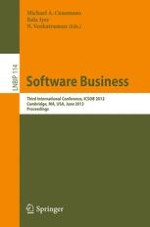This book contains the refereed proceedings of the Third International Conference on Software Business (ICSOB) held in Cambridge, MA, USA, in June 2012. The software business refers to commercial activities in the software industry, aimed at generating revenues from the design, delivery, and maintenance of software products and IT services to enterprises and individual customers, as well as from digital content. Although this business shares common features with other knowledge-intensive markets, it carries many inherent features making it a challenging domain for research. The 20 full and 10 short papers accepted for ICSOB were selected from 60 submissions and are organized in sections on software product management, organizational transformation, industry transformation, software platforms and ecosystems, and emerging trends.
